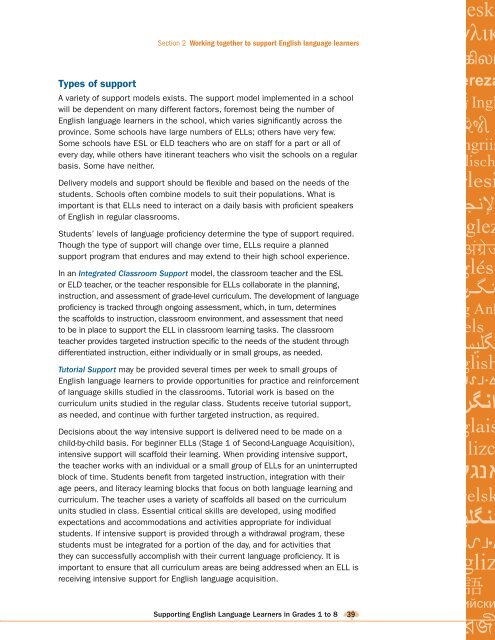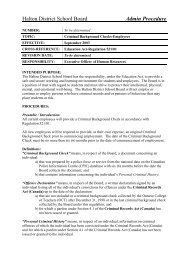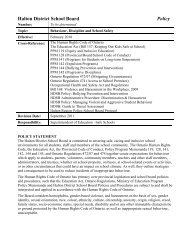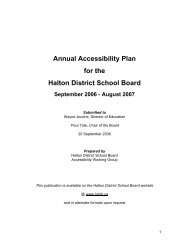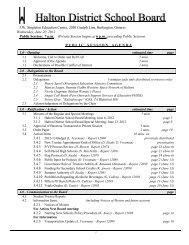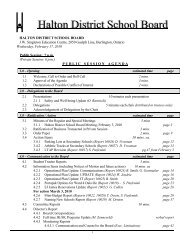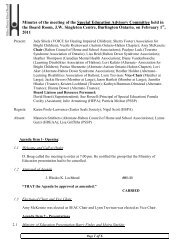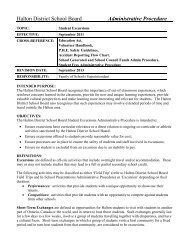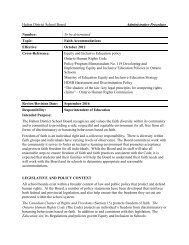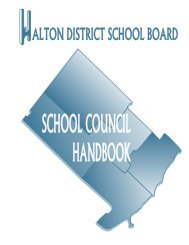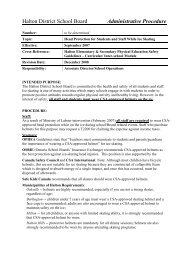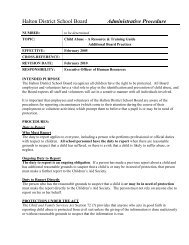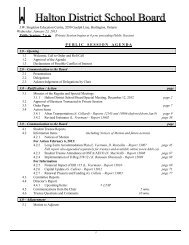Supporting English Language Learners in Grades 1 to 8
Supporting English Language Learners in Grades 1 to 8
Supporting English Language Learners in Grades 1 to 8
You also want an ePaper? Increase the reach of your titles
YUMPU automatically turns print PDFs into web optimized ePapers that Google loves.
Section 2 Work<strong>in</strong>g <strong>to</strong>gether <strong>to</strong> support <strong>English</strong> language learners<br />
Types of support<br />
A variety of support models exists. The support model implemented <strong>in</strong> a school<br />
will be dependent on many different fac<strong>to</strong>rs, foremost be<strong>in</strong>g the number of<br />
<strong>English</strong> language learners <strong>in</strong> the school, which varies significantly across the<br />
prov<strong>in</strong>ce. Some schools have large numbers of ELLs; others have very few.<br />
Some schools have ESL or ELD teachers who are on staff for a part or all of<br />
every day, while others have it<strong>in</strong>erant teachers who visit the schools on a regular<br />
basis. Some have neither.<br />
Delivery models and support should be flexible and based on the needs of the<br />
students. Schools often comb<strong>in</strong>e models <strong>to</strong> suit their populations. What is<br />
important is that ELLs need <strong>to</strong> <strong>in</strong>teract on a daily basis with proficient speakers<br />
of <strong>English</strong> <strong>in</strong> regular classrooms.<br />
Students’ levels of language proficiency determ<strong>in</strong>e the type of support required.<br />
Though the type of support will change over time, ELLs require a planned<br />
support program that endures and may extend <strong>to</strong> their high school experience.<br />
In an Integrated Classroom Support model, the classroom teacher and the ESL<br />
or ELD teacher, or the teacher responsible for ELLs collaborate <strong>in</strong> the plann<strong>in</strong>g,<br />
<strong>in</strong>struction, and assessment of grade-level curriculum. The development of language<br />
proficiency is tracked through ongo<strong>in</strong>g assessment, which, <strong>in</strong> turn, determ<strong>in</strong>es<br />
the scaffolds <strong>to</strong> <strong>in</strong>struction, classroom environment, and assessment that need<br />
<strong>to</strong> be <strong>in</strong> place <strong>to</strong> support the ELL <strong>in</strong> classroom learn<strong>in</strong>g tasks. The classroom<br />
teacher provides targeted <strong>in</strong>struction specific <strong>to</strong> the needs of the student through<br />
differentiated <strong>in</strong>struction, either <strong>in</strong>dividually or <strong>in</strong> small groups, as needed.<br />
Tu<strong>to</strong>rial Support may be provided several times per week <strong>to</strong> small groups of<br />
<strong>English</strong> language learners <strong>to</strong> provide opportunities for practice and re<strong>in</strong>forcement<br />
of language skills studied <strong>in</strong> the classrooms. Tu<strong>to</strong>rial work is based on the<br />
curriculum units studied <strong>in</strong> the regular class. Students receive tu<strong>to</strong>rial support,<br />
as needed, and cont<strong>in</strong>ue with further targeted <strong>in</strong>struction, as required.<br />
Decisions about the way <strong>in</strong>tensive support is delivered need <strong>to</strong> be made on a<br />
child-by-child basis. For beg<strong>in</strong>ner ELLs (Stage 1 of Second-<strong>Language</strong> Acquisition),<br />
<strong>in</strong>tensive support will scaffold their learn<strong>in</strong>g. When provid<strong>in</strong>g <strong>in</strong>tensive support,<br />
the teacher works with an <strong>in</strong>dividual or a small group of ELLs for an un<strong>in</strong>terrupted<br />
block of time. Students benefit from targeted <strong>in</strong>struction, <strong>in</strong>tegration with their<br />
age peers, and literacy learn<strong>in</strong>g blocks that focus on both language learn<strong>in</strong>g and<br />
curriculum. The teacher uses a variety of scaffolds all based on the curriculum<br />
units studied <strong>in</strong> class. Essential critical skills are developed, us<strong>in</strong>g modified<br />
expectations and accommodations and activities appropriate for <strong>in</strong>dividual<br />
students. If <strong>in</strong>tensive support is provided through a withdrawal program, these<br />
students must be <strong>in</strong>tegrated for a portion of the day, and for activities that<br />
they can successfully accomplish with their current language proficiency. It is<br />
important <strong>to</strong> ensure that all curriculum areas are be<strong>in</strong>g addressed when an ELL is<br />
receiv<strong>in</strong>g <strong>in</strong>tensive support for <strong>English</strong> language acquisition.<br />
<strong>Support<strong>in</strong>g</strong> <strong>English</strong> <strong>Language</strong> <strong>Learners</strong> <strong>in</strong> <strong>Grades</strong> 1 <strong>to</strong> 8 39


